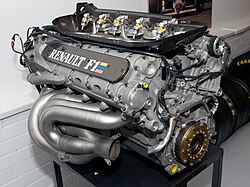| Renault RS engine | |
|---|---|
 | |
| Overview | |
| Manufacturer | Mecachrome (1998 only) Playlife (1998–2000) Supertec (1999–2000) |
| Designer | Bernard Dudot (RS1–RS9) |
| Production | 1989–2013 |
| Layout | |
| Configuration | 67°/71°/111°/72° V10; [1] 90° V8 |
| Displacement |
|
| Cylinder bore | |
| Piston stroke | |
| Combustion | |
| Fuel system | Electronic multi-point indirect fuel injection |
| Fuel type | Gasoline |
| Cooling system | Water-cooled |
| Output | |
| Power output | 650–900 hp (485–671 kW; 659–912 PS) |
| Torque output | 221–340 lb⋅ft (300–461 N⋅m) |
| Dimensions | |
| Dry weight | 90–141 kg (198.4–310.9 lb) [4] |
| Chronology | |
| Predecessor | EF |
| Successor | E-Tech |
The RS series is a family of naturally-aspirated Grand Prix racing engines, designed, developed and manufactured jointly by Mecachrome and Renault Sport for use in Formula One, and used by Arrows, BAR, Williams, Ligier, Lotus, Caterham, Benetton, Renault, and Red Bull, from 1989 until 2013. [4] The engines came in both the original V10, and later V8 configurations, and engine displacement ranged from 2.4 L (150 cu in) to 3.5 L (210 cu in) over the years. Power figures varied; from 650 hp (480 kW) at 12,500 rpm, to later over 900 hp (670 kW) at 19,000 rpm. [5] The 2.4-litre RS26 V8 engine, used in 2006, is one of the highest revving Formula One engines in history, at 20,500 rpm. [6] [7] [8] [9] Between 1998 and 2000, the RS9 engines were badged as Mecachrome, Supertec, and Playlife.



